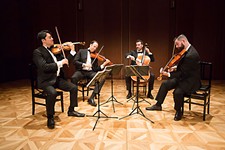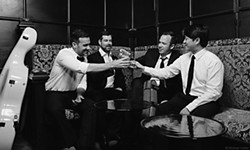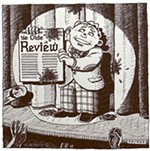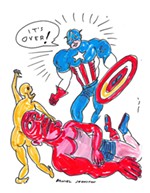Teaching Intimacy
The Miró Quartet reveals the key to developing a great chamber music ensemble
By Robert Faires, Fri., May 7, 2010

In the classical world, chamber musicians are the most democratic. They have no conductor they get to follow, no authority figure with a baton on whom all eyes are trained and from whom everyone takes their cue. Each player is equally responsible for setting the tempo and tone of a work, and so the playing of a chamber piece is an intricate, ongoing negotiation of individual artists to fashion a cohesive musical whole. It demands a sense of not only the music but also the styles and temperaments of the group's other members and a willingness to give as much as one takes.
The members of the Miró Quartet – Daniel Ching, first violin; Sandy Yamamoto, second violin; Joshua Gindele, cello; and John Largess, viola – have had 15 years to hone that level of groupthink and sensitivity to one another, on and off the concert hall stage. And as the resident string quartet of the University of Texas' Butler School of Music, they are also teachers called to train budding chamber musicians in how to play as a unit. As another semester winds down and the quartet prepares for its first concert with celebrated cellist Lynn Harrell, Miró members Gindele and Largess sat down to talk about the mystery of ensemble playing in a chamber group – both how they learned it and how they teach it.
Austin Chronicle: Earlier this year, after David Soyer of the Guarneri Quartet died, David Finckel of the Emerson String Quartet told a story on his blog about asking Soyer for advice on how his group should follow one another. Soyer's response was: "If you only follow, you will inevitably be behind – you must lead together with the same motions, strike the string in the same way, at the same time, and then you will be truly together."
John Largess: That's a lesson we learned very early on as a quartet – actually, we all started learning that lesson before we all started playing together. That's really sort of the essence of being an ensemble, when you're trying to be four individuals that can play as one, not only play as one but when you choose to play as one. And that requires that ability of being able to do things spontaneously together, which means not always making a plan that you, quote-unquote, follow or having someone be the leader and everyone else follows. It doesn't matter if you're in a jazz combo or a string quartet of a rock band – it won't work well if the proportional energy of all the players is disproportionate. We all feel like we need to put in 25 percent of leading energy. Leading, even though it implies you're in front, has an element of guiding to it in the meaning, and that's what we do when we lead: We're there to be aware of the other people and help guide the group in the direction that we want to go. That means being receptive and flexible, too.
Joshua Gindele: I think the issue with our quartet from the get-go was not an issue of leadership, because the four of us were such strong musical personalities as individuals.
Largess: Very strong.
Gindele: We didn't need to work terribly hard on being assertive. We needed to work on being malleable and giving other people room for their personalities to come out. That for us was the biggest thing: when to give leadership to somebody else.
Largess: And when to trust that when you gave up that leadership, everything would be fine. We were all used to being soloists and the type of people who say, "We take control." Giving up control doesn't feel that good.
AC: That seems like something that is easier to grasp intellectually than employ in practice.
Largess: The concept is easy in some ways to explain intellectually. Unfortunately, understanding it intellectually doesn't mean you can do it in practice. It's the same as explaining to somebody how you do a pole vault correctly. If you don't actually know what it feels like, it doesn't matter how well you understand the vectors, how your joints should be balanced, the theoretical science of it.
Part of what we do when we teach chamber music now is get the students' attention off of themselves and focused on the other people in the group or what the group as a unit is doing versus what individuals are doing. There are so many more senses besides looking or listening. There are so many more ways of being aware, and a lot of what we do when we teach is cultivate that awareness. Not to get too touchy-feely, but it's a little more like doing an Outward Bound adventure project, where the activities are sort of peripheral to the mindset you're trying to instill. You don't have to talk about the concepts of leading and following over and over if you're exercising their awareness. Sometimes when you try too hard with your mind to be in this place, you're not in this place. A lot of it's about letting go and feeling what the other person is about to do.
Gindele: One of the problems we have as musicians is that we have so much to do physically to execute something that we have a hard time getting outside of ourselves. I think the hardest thing for students is that they haven't learned to execute something physically while maintaining a soft focus on themselves instead of a really intense focus. You have to teach them to focus in a way that gives them space in their brain to be aware of what's going on around them.
Largess: Yeah, if you're using 100 percent of your brainpower to do your part, then you have no brainpower left ....
Gindele: To do anything else.
Largess: A lot of it is good life lessons as far as letting go of control, having a broader awareness, less focus on yourself.
AC: My background is theatre, and as a younger actor I felt that being onstage was about acting, getting all intense and projecting that, and in later years I've discovered that the key is really relaxing and being more of myself. Whatever I'm trying to do with the character comes through much more easily than when I pushed so hard.
Largess: When you're planning your technique, when you're observing yourself as you act, there's a lack of authenticity. And in chamber music, because there's no conductor to tell you what to do, because you're not a soloist who has lots of leeway and anything you feel like doing in the moment is okay, because you have the constraints of other people and are challenged by the differences of other people, you really have to have a certain authenticity and relaxedness when you play. Otherwise, it just sounds terrible. It sounds bad. That skill set we're talking about – of awareness and relaxing and authenticity – has to really be practiced.
AC: Can you remember the moment when these ideas clicked for you as a performer?
Gindele: Yes. After the quartet had started, I remember being in Aspen as part of the quartet program [at the Aspen Music Festival]. We had a mentor – his name was Tim Eddy; he's in the Orion [String] Quartet – and I remember him talking with us about this idea of malleable conviction: doing something with conviction yet creating space for others to do things with conviction at the same time. I think maybe I was old enough to understand it at that point. It might have been taught to me younger, but I don't know if I was mature enough to grasp the concept. It was a real lightbulb for me.
[Another] one of our primary mentors was Donald Weilerstein, the first violinist of the Cleveland Quartet. He was always talking about sort of out-there concepts, like feeling each other's hands as they touch the fingerboard and connecting in a physical way with one another. He talked a lot about helping each other, which I think is a great concept.
Largess: It's an attitude switch you flip on. I remember one of the things Don used to say was really simple, but I thought it was funny: See if you can guess what they're going to do before they do it. You don't know what they're going to do, but see if you can know slightly before they know what it is that they're going to do. That feeling of being open and discovering it together and trying to help is so different than most of my musical upbringing. "You need to sound better than somebody else," or "you need to measure up to a certain standard" – all these reductionary ideas. And this with Don was very expansive.
Gindele: But those ideas are inherent in the quartet anyway. We're all sitting next to one another. We have to play up to one another's levels constantly. I learn more from these guys than I've learned from any teacher I ever had.
Largess: I think all four of us, without maybe knowing it consciously, are players that play best when challenged and mixed with other people. Not everybody who is a musician is like that, but I think in some ways we're all more comfortable with being part of a musical group, a larger mind.
Gindele: Our goal was to create a nonhierarchical group, and that really took checking all our egos at the door when we joined the group, understanding that maybe I'm not doing this best, maybe I do have something to learn. That's always the hardest thing for anybody to do, check their ego at the door.
AC: I would imagine that for some students that's relatively easy, but for a lot, it's not.
Largess: For most, it's not. We do have a few students, for example, who play their best when they're playing in string quartets. But for the majority, it's a challenge. As Josh says, it challenges you to play better with less energy, with more awareness, with less focus on yourself. And you really master and integrate the skills of your instrument when you're doing them almost unconsciously and in a way that's not planned.
One of the things we also stress is we're not practicing something and planning exactly how the four of us will do it so that we can get onstage and execute it exactly the same way every single time. Some groups do that, but that's not our philosophy of playing, so training to be able to do something equally well whether you've practiced a hundred times or you've never done it before onstage, that's a different level of artistic mastery than drilling something so you can do it a certain way. You have to have that element of adaptability and being in the moment.
Gindele: Another very good life lesson.
AC: So what exercises do you use with your students to help them absorb these concepts?
Gindele: It depends on the ensemble. If you sense an imbalance in leadership, you approach it one way. I do a lot of things where I make students learn to trust one another, like I'll turn them around so they can't see each other and play. A lot of leadership in music is visual, so you need to learn how to feel each other and trust one another.
AC: Get their Spider-sense working?
Gindele: Exactly!
Largess: Yes, feeling the Force. We project so much energy when we perform, you should be attuned to that. You have the audience attuned to that, and your fellow performers should be in tune with what you're doing.
Gindele: I'm also starting to understand more and more after – how long have we been teaching? Eleven years? – that you can really feel in a group when somebody is taking leadership and gives up leadership; it's something that's tangible. I tend to sit in groups now more than I ever used to. I used to talk at them; now I try to get in there and feel what they're feeling and see if I can influence how they interact.
Largess: Well, it's experience. When you've experienced that flow of energy and that different quality of awareness, then you can strive to capture it. Just talking about it or having words to explain it is not the same as experiencing it. I like having kids use their voices to articulate the musical intention that they want as a group, because so often students are not really clued in to what their intention is. I find that a lot of times taking the instruments away removes an intellectual barrier to awareness.
Gindele: You can take that another step by taking just one element away. We have a lot of groups do things with just their left hands, because you can really project your intention and energy just with this. [Holds up left hand] You would think without creating sound with the bow that you wouldn't be able to play together, but you can actually use your physical energy to lead something without being able to hear it.
AC: I love this idea of feeling without necessarily seeing, but how often do you work off visual cues?
Largess: Often. It's not always as simple as someone gives a sign and you do what they show, but I've seen the other three I play with play so often, I know what they're going to do by just watching their bodies. But a lot of it is in listening to how they breathe, feeling how they breathe, seeing how they breathe, those kinds of things more than watching their fingers or watching their bow about to move.
Gindele: It may be also because of where I sit in the group, but I tend to watch a lot of tiny physical cues, like I can tell what's going to happen right there, right on the tip of the third finger. I can tell by the way Daniel flexes his pinky when he's actually going to strike the string. A lot of it is feel, but a lot is intense observation of tiny details.
AC: So as an ensemble you get to know one another's movements on a microscopic level, and that feeds into the group creation of the piece.
Gindele: Sure. It's the sum of all the individual parts that makes each group unique. And maybe the most important thing, the primary function of the group, is understanding each other in a personal way. When you talk about intimacy, that's what I think about. I don't think about how we play together; I think about how we interact and what the relationship skills are that we developed in order to work with one another.
You have to be assertive, yet flexible. There's that malleability again in our interpersonal relationships which really defines the group. Our ability to get along with one another, our ability to give one another space, our ability to be assertive with one another without our egos absorbing a blow or feeling like we're being defensive or aggressive is the real essence of the group. And it's the real essence of any group. Think about all the great examples in rock & roll history of interpersonal relationships being the catalyst for an explosion in a group. It's something we're constantly working on still, after 15 years, and something we try to instill in our students maybe more than anything else.
The Miró Quartet performs with cellist Lynn Harrell on Sunday, May 9, 4pm, in Bates Recital Hall, 2420 Robert Dedman Dr. For more information, call 471-5401 or visit www.music.utexas.edu.










